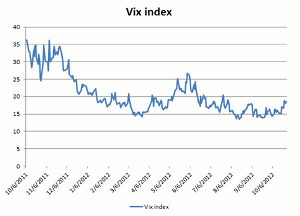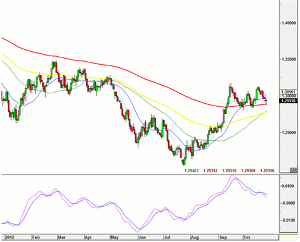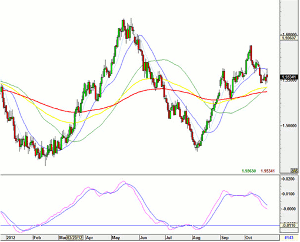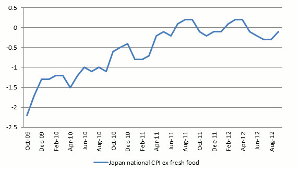Kathleen Brooks and Eric Viloria, CMT, of Forex.com highlight the events and indicators likely to shape the forex markets this week.
The risk trade softens
Stock markets declined last week, commodities fell and Spanish bond yields rose last week as sentiment drained from the market. The key drivers of lower markets were weak economic data out of Europe, strong data out of the US, which threatens to cut QE3 short, and weak Q3 corporate earnings.
The S&P 500 has seen 30% of companies that have reported so far miss earnings estimates. The sales miss has been worse, with only 40% of companies meeting expectations or exceeding them. There have been some notable misses for the tech sector including Apple, Google, Intel, and Microsoft. Other industries that have been under pressure include the mining and resource sector and utilities. Since the tech sector is considered a lead economic indicator, the decline in Q3 earnings could precede a sharper slowdown in the broader economy. The Nasdaq 100 index is testing a key support level at 2,655, the 200-day sma, below here opens the way for a steeper decline to back to the May lows. If it breaks below here then it may signal broader declines in global equity markets.
So as we start a new week risk assets look vulnerable to a further decline. It doesn’t look like Spain is in any hurry to apply for a bailout (see the European section for more), European data is likely to remain fairly weak for some time and as we enter the last full week of trading before the US Presidential election nervousness is starting to build about the fiscal cliff. The US is not the only one edging towards the cliff edge, Japan is too. It is facing a political standoff over its budget, which could cause the world’s largest debtor to run into financial trouble as soon as the end of November (see the Japan section for more).
Figure 1: The VIX index—this is considered Wall Street’s fear gauge. It has started to edge higher in recent weeks. Upcoming event risks could see this index pop above 20—the August high.

Source: Forex.com and Bloomberg
Click
to Enlarge
Will the Eurozone Crisis Flare Up Before Year End?
The sovereign debt crisis seems to have lost some of its potency to rattle financial markets in recent months. Since ECB President Draghi said the Bank would do whatever it takes to save the Eurozone at the end of July, Spanish bond yields continue to fall. Even after rising last week they still closed the week below 5.6% and remain well below the 7% line in the sand. The recovery in the bond market seems all the more impressive since the ECB’s bond-buying OMT program has not yet been activated and Spain’s economy has deteriorated further, the unemployment rate rose to more than 25% in the third quarter.
So is the market due a panic? There are lots of things to panic about, not least the deteriorating growth picture across the currency bloc and not just in Spain. Added to that Greece has still not managed to secure its next EU30bn tranche of bailout funds. The Greek parliament will vote on required fiscal measures that are needed to get the bailout funds next week; however this vote is expected to pass easily. There are rumors that Greece’s centre-right government has a better relationship with Brussels, and thus may be able to secure better bailout conditions—for example lower interest rates and a longer debt repayment schedule. Added to this, Spain has issued most of its debt for this year already, which means it is unlikely to see a sustained attack on its bond market before year end.
This reduces the chance of a full-scale panic in our view. Germany’s stance could also help calm the markets. Berlin seems to be willing to give concessions to Greece and Ireland to keep the currency bloc together, likewise, relations between Berlin and the ECB seem to have recovered. After a split over the OMT program (the Bundesbank were against) the fact it hasn’t been activated has placated Germany’s central bank. Added to that Draghi has been at pains to placate Germany and last week warned the German Parliament that the biggest risk was deflation and the inflation hawks on the Bundesbank had nothing to fear from the OMT program. Eurozone inflation is expected to have declined to 2.5% this month from 2.7% in September when it is released this week.
NEXT PAGE: QE—Down But Not Out for the UK |pagebreak|
Thus, it appears that the political side of the sovereign debt crisis could remain stable for some time. The bigger risk in our view is the economy. This is deteriorating rapidly. Recent PMI surveys saw the French readings drop away from the core economies and start to resemble the periphery. This is extremely concerning, as France is the second largest economy in the currency bloc and one of its main paymasters along with Germany. In Spain more than a quarter of people are unemployed, which is likely to weigh on the Eurozone unemployment figure released next week. This is expected to reach another record high of 11.4% for September. Added to that Spain releases its Q3 GDP report next week and the market expects a 0.4% decline after receiving guidance from the Bank of Spain. German data including employment and retail sales will also be scrutinized to see if they suggest further weakness in the currency bloc’s largest economy.
The sell-off in the euro last week coincided with weak PMI data from the Eurozone, thus further declines in economic data could cause more pressure on the single currency. EURUSD closed the European session last week above 1.29, safely above a key support zone between the top of the daily Ichimoku cloud at 1.2950 and 1.2980—the 200-day sma. Below here would suggest a more prolonged downtrend for this cross. If the data next week is truly horrible then we expect a sharp fall to 1.2800 and then 1.2750—the low from the middle of September - in the short term.
Figure 2: EURUSD daily chart

Source: Forex.com
Click
to Enlarge
QE—Down But Not Out for the UK
Those looking for more QE from the Bank of England when it meets next month were dealt a blow last week when Q3 GDP data rose 1%, taking the UK out of recession in style. The data was boosted by an extra working day compared with Q2 and also Olympic and Paralympic ticket sales, both temporary factors. Although the exact impact of these events on growth is still unknown, it is likely that the underlying rate of growth last quarter was around 0.3-0.4%. This is better than the first half of the year but it remains moderate and does not guarantee that the UK’s economy is out of the woods yet, especially since our largest trading partner, the Eurozone, remains mired in recession.
There is a lot of uncertainty surrounding the outlook for the UK economy. Although the industrial sector saw a healthy gain in the third quarter, its performance may have slowed at the start of Q4 after the CBI industrial trends survey fell to its lowest level for two years. Thus, next week’s October PMI surveys are going to be crucial to the QE decision at the next BOE meeting on 8th November. The market expects a decline to 48.0 for the manufacturing survey from 48.4 in September. If the market is correct then it reverses better data over the third quarter and suggests growth may already be slowing and the UK economy could be on course for a triple-dip.
The Governor of the Bank of England Mervyn King was speaking last week and he left the door open to more QE. However, King is a noted dove and we know from the minutes of the September meeting that there is a split between some members wanting more stimuli and some preferring to stay on hold. Thus, the decision next month will likely be a close call.
The pound was volatile last week but GBPUSD ended the week higher after receiving a boost from the GDP data. This pair is likely to remain range bound for the short-term between 1.5800 and 1.6150. It is also sensitive to overall market risk, so if we see market sentiment continue to drain then we may test the top of the daily cloud at 1.6065—a key support zone. Below here is the end of a technical uptrend and suggests further losses back to 1.5850—the bottom of the daily cloud. GBPAUD seems more constructive especially as the RBA maintains its dovish outlook. If the UK PMI data surprises on the upside next week then we may see this cross move back above 1.5600 towards the 1.5800 highs from earlier this month as it would increase the chances that the BOE will remain on hold next month.
Figure 3: GBPAUD daily chart

Source: Forex.com
Click
to Enlarge
NEXT PAGE: Bank of Japan Under Pressure to Ease
|pagebreak|Bank of Japan Under Pressure to Ease
On October 30, the Bank of Japan will announce monetary policy as well as release its semiannual Outlook for Economic Activity and Prices. We anticipate that the report will show a reduction in inflation forecasts, which underscores the fact that the BoJ is struggling to achieve its 1% inflation target. Expectations are that the Bank will miss this target as far out as 2014. Therefore, we expect the Bank to respond with more stimulus in the form of yet another increase to the Asset Purchase Program (APP). The APP currently stands at ¥80T and markets have been speculating increases of between ¥10-20T in additional purchases.
The economy may have fallen back into contraction in Q3 as incoming data has been weak. Consumer spending has declined, and exports dropped significantly. As Japan is heavily reliant on exports, measures taken by the Bank to weaken the yen would be beneficial on the margin. However, the strength of the currency is only one factor that is weighing on the export driven economy. Geopolitical tensions and slowing global growth as a result of increased uncertainties have reduced demand for Japanese exports. A drop in economic activity will weigh on prices, which have been indicating deflation for some time. On Friday, Japan’s consumer price data showed national CPI falling by -0.3% y/y in September on the headline print while CPI excluding fresh food fell -0.1% y/y. More timely Tokyo price readings also showed deflation persisted in October.
The BoJ has been faced with increased pressure to ease further from the government. Economy Minister Maehara, who sat at the BoJ meeting earlier this month, said that he wants the Bank to pursue easing to achieve its price goal and also indicated that he may attend next week’s meeting.
The JPY was mostly softer earlier this past week after weak fundamental data and ahead of the BoJ meeting. Friday a reversal of yen weakness after the government proposed new fiscal stimulus and after better than expected CPI figures (however the numbers continued to show deflation as previously noted). With the potential for further easing from the BoJ, there is scope for JPY weakness heading into the meeting and even a knee jerk reaction lower in the yen following the announcement should the Bank take on additional measures. In the long run, we would prefer to fade yen weakness as increases to the Bank’s APP have not had lasting impacts on the exchange rate.
In fact, at the September 19 meeting when the BoJ last expanded stimulus by ¥10T, USD/JPY actually declined on the session. The Bank not only increased the amount of purchases then but also the length of the program which resulted in a slower pace of buying. It is likely that the Bank may make adjustments to the program to take a more aggressive stance to providing monetary easing.
NEXT PAGE: Japan Continues to Struggle with Deflation
The 200-day simple moving average (SMA) remains the key pivot and is currently acting as support. The daily Tenkan line also converges with the 200-day SMA around the 79.50 level. A break below here is likely to see USD/JPY move back towards the bottom end of its recent range. To the upside, the 80.50 level is key resistance and a close above is needed for gains to extend. While BoJ action may result in short term yen weakness, we doubt that USD/JPY upside can last without support from higher US treasury yields.
Figure 4: Japan continues to struggle with deflation

Source: Bloomberg
Click
to Enlarge
US Employment Data in Focus
This week indicators of US employment in October are due for release. As usual, the first Friday of the month will see the Bureau of Labor Statistics (BLS) monthly employment report, which tends to have a large impact on markets. The private ADP report, which is due out on Thursday may take on more importance as new enhancements have been made. As indicated by ADP, the report has been enhanced “to further align with the final, revised US BLS numbers. A look back at historical data from 2001 to present using the new methodology shows a very strong correlation (96%) with revised BLS numbers.”
So what is different with the report? ADP now uses a larger sample size of 406K companies (prev. 344K) and 23 million employees (prev. 21M) which accounts for more than 20% of all US private sector employees. Expectations are for ADP to show a gain of 135K payrolls in October from the prior 162K while the BLS is anticipated to show a headline change of 120K jobs from the prior 114K. After experiencing a decline of 0.5% in the past 2 months, the unemployment rate is expected to correct slightly higher to 7.9%.
In our view, prints in the low to mid-100K range are lackluster and not likely to inspire a significant improvement in risk sentiment. Furthermore, readings in the previously mentioned range are unlikely to cause the Fed to change course in its current easing program.
By Kathleen Brooks and Eric Viloria, CMT, of Forex.com




















